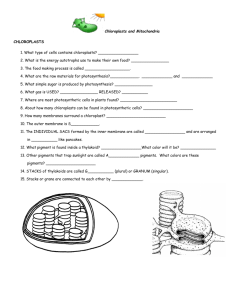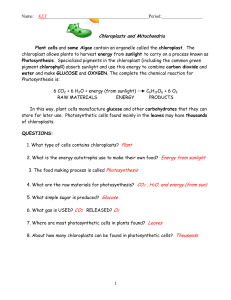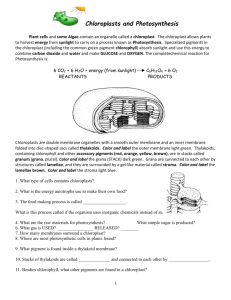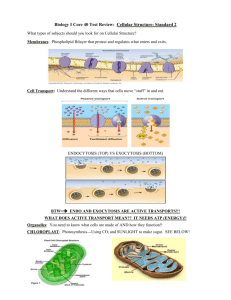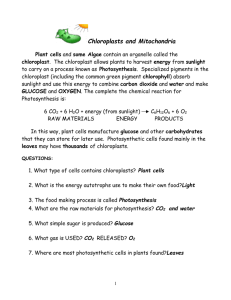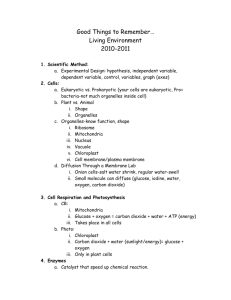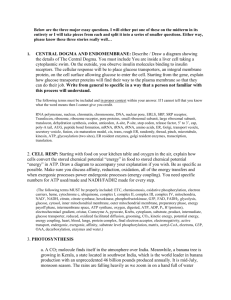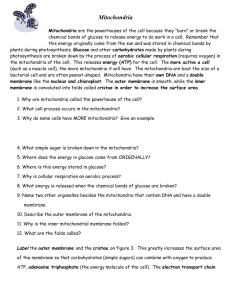Chloroplasts_and_Mitochondria_Answers
advertisement
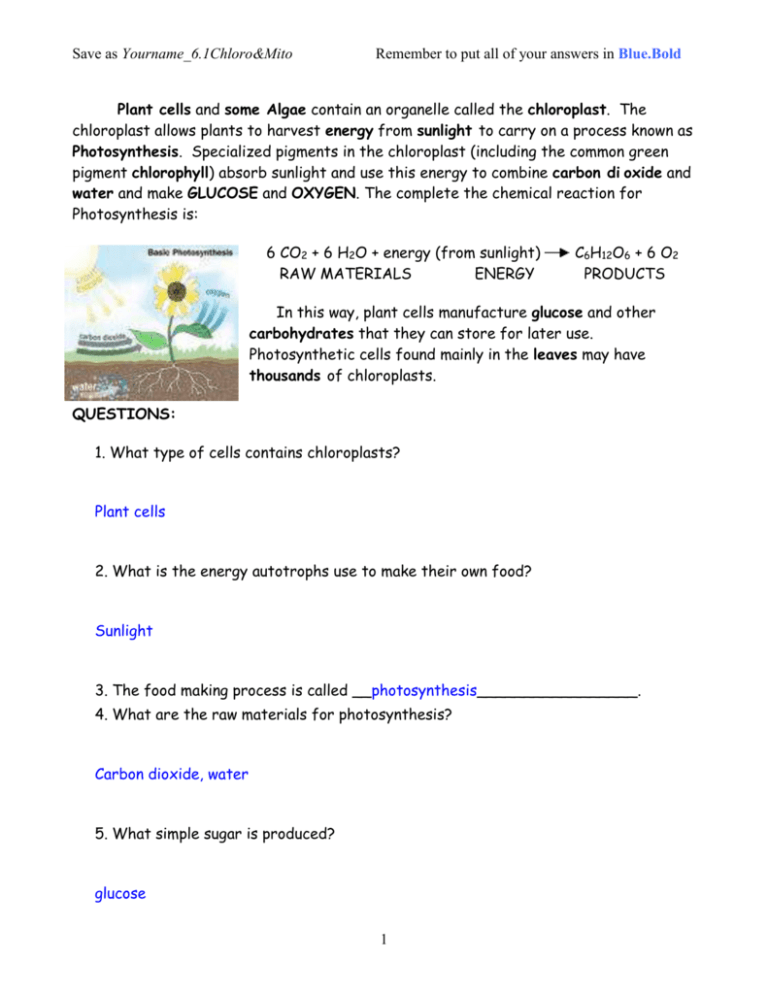
Save as Yourname_6.1Chloro&Mito Remember to put all of your answers in Blue.Bold Plant cells and some Algae contain an organelle called the chloroplast. The chloroplast allows plants to harvest energy from sunlight to carry on a process known as Photosynthesis. Specialized pigments in the chloroplast (including the common green pigment chlorophyll) absorb sunlight and use this energy to combine carbon di oxide and water and make GLUCOSE and OXYGEN. The complete the chemical reaction for Photosynthesis is: 6 CO2 + 6 H2O + energy (from sunlight) RAW MATERIALS ENERGY C6H12O6 + 6 O2 PRODUCTS In this way, plant cells manufacture glucose and other carbohydrates that they can store for later use. Photosynthetic cells found mainly in the leaves may have thousands of chloroplasts. QUESTIONS: 1. What type of cells contains chloroplasts? Plant cells 2. What is the energy autotrophs use to make their own food? Sunlight 3. The food making process is called __photosynthesis_________________. 4. What are the raw materials for photosynthesis? Carbon dioxide, water 5. What simple sugar is produced? glucose 1 Save as Yourname_6.1Chloro&Mito Remember to put all of your answers in Blue.Bold 6. What gas is USED? __carbon dioxide______________ RELEASED? _oxygen_______ 7. Where are most photosynthetic cells in plants found? leaves 8. About how many chloroplasts can be found in photosynthetic cells? thousands Chloroplasts are double membrane organelles with a smooth outer membrane and an inner membrane folded into disc-shaped sacs called thylakoids.. Thylakoids, containing chlorophyll and other accessory pigments (which are red, orange, yellow, brown), are in stacks called granum (grana, plural. Grana are connected to each other by structures called lamellae, and they are surrounded by a gel-like material called stroma. 9. How many membranes surround a chloroplast? 2 10. The outer membrane is Smooth____________. 2 Save as Yourname_6.1Chloro&Mito Remember to put all of your answers in Blue.Bold 11. The INDIVIDUAL SACS formed by the inner membrane are called __thylakoids_______________ and are arranged in __stacks_________ like pancakes. 12. What pigment is found inside a thylakoid? What color will it be? Chlorophyll, green 13. Other pigments that trap sunlight are called A_cessory____________ pigments. What colors are these pigments? Red, orange, yellow, brown 14. STACKS of thylakoids are called G_rana__________ (plural) or GRANUM (singular). 15. Stacks or grana are connected to each other by _lamellae____________. 3 Save as Yourname_6.1Chloro&Mito Remember to put all of your answers in Blue.Bold Mitochondria are the powerhouses of the cell because they “burn” or break the chemical bonds of glucose to release energy to do work in a cell. Remember that this energy originally came from the sun and was stored in chemical bonds by plants during photosynthesis. Glucose and other carbohydrates made by plants during photosynth esis are broken down by the process of aerobic cellular respiration (requires oxygen) in the mitochondria of the cell. This releases energy (ATP) for the cell. The more active a cell (such as a muscle cell), the more mitochondria it will have. The mitochondria are bout the size of a bacterial cell and are often peanut-shaped. Mitochondria have their own DNA and a double membrane like the nucleus and chloroplast. The outer membrane is smooth, while the inner membrane is convoluted into folds called cristae in order to increase the surface area. 16. Why are mitochondria called the powerhouse of the cell? Break down glucose to release energy 17. What cell process occurs in the mitochondria? Aerobic cellular respiration 18. Why do some cells have MORE mitochondria? Give an example. More active, requiring more energy, like muscle cell 19. What simple sugar is broken down in the mitochondria? glucose 20. Where does the energy in glucose come from ORIGINALLY? Photosynthesis 21. Where is this energy stored in glucose? 4 Save as Yourname_6.1Chloro&Mito Bonds Remember to put all of your answers in Blue.Bold 22. Why is cellular respiration an aerobic process? Requires oxygen 23. What energy is released when the chemical bonds of glucose are broken? ATP 24. Name two other organelles besides the mitochondria that contain DNA and have a double membrane. Chloroplast and nucleus 25. Describe the outer membrane of the mitochondria. Smooth 26. Why is the inner mitochondrial membrane folded? Folds increase surface area 27. What are the folds called? cristae Adenosine triphosphate (ATP) is the energy molecule used by all cells to do work. It is a nucleotide consisting of a nitrogen-containing base (adenine, thymine, cytosine, or guanine), a 5-carbon sugar, and 3 phosphate groups. ATP is able to store and transport chemical energy within cells. The LAST TWO phosphate groups (PO4), are joined by HIGH-ENERGY bonds. When these bonds are broken, energy is released for cells to use and ADP forms. Enzymes help to break and reform these high-energy bonds. 28. What does ATP stand for? 5 Save as Yourname_6.1Chloro&Mito Remember to put all of your answers in Blue.Bold 29. What three main things make up an ATP molecule? Ribose sugar, 3 phosphate groups, adenine 30. How many high-energy bonds does ATP contain? 2 31. Where are these high-energy bonds found in ATP? Phosphate bonds 32. What helps weaken these bonds so energy can be released and then later help reform them? enzymes 33. When ATP loses a phosphate group ____energy______ is released for cells and a molecule of _ADP________ forms. 6
